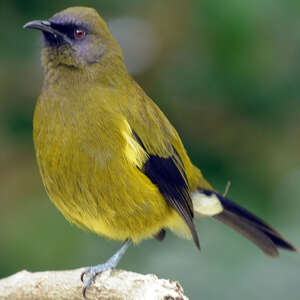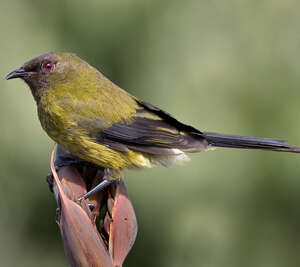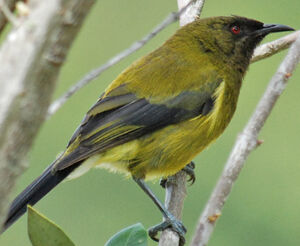New Zealand Bellbird
Anthornis melanura - Méliphage carillonneur
Identification
The overall look is that of a dark green bird with a slightly downcurved bill. The male is greenish, paler underneath than above, with a purplish head reflection. The remiges and rectrices are blue-black, the eye is red. In the female, the colours are duller, the head does not have the purple reflections of the male's head, remiges and rectrices are more brownish. Distinctive character, a narrow white moustache. The young resemble the female but have a brown eye and a yellowish moustache. The further south, the darker the birds are. The species is commonly known as the New Zealand Bellbird.
Subspecific information 3 subspecies
- Anthornis melanura melanura (North I., South I. and many offshore islands)
- Anthornis melanura obscura (Three Kings I.. nw of North Island.)
- Anthornis melanura oneho (Poor Knights Is.. e of North Island.)
Foreign names
- Méliphage carillonneur,
- Mielero maorí,
- sininho-maori,
- Maorihonigfresser,
- csengőmadár,
- Maoribelhoningvogel,
- Campanaro di Nuova Zelanda,
- korimako,
- Maorihonningeter,
- medárik makomako,
- medosavka novozélandská,
- Newzealandsk Bjældefugl,
- makomako,
- menjamel de Nova Zelanda,
- szmaragdowiec (zwyczajny),
- Медосос-колокольчик,
- ニュージーランドミツスイ,
- 新西兰吸蜜鸟,
- korimako,
- 鐘吸蜜鳥,
Voice song and call
The song, very variable and quite harmonious, is a succession of low, liquid notes. The bird can sing continuously for several tens of minutes, with male and female singing in duet. The call is composed of repeated notes that can be transcribed as tink tink tink or yeng yeng yeng. The New Zealand Bellbird can sing such a song.
Habitat
The New Zealand Bellbird is mainly a forest bird with a clear preference for native woodlands, although it can sometimes be found in some plantations of Eucalyptus or other exotic species. From what I have seen in the Auckland region, it also frequents parks and gardens. It can be seen from the coast to around 1,200 metres altitude.
Behaviour character trait
Dietfeeding habits
Reproduction nesting
The breeding period varies depending on the region, generally stretching from September to February. Some couples have two clutches, but this is not the majority.
The female builds the nest (about 15 cm in diameter) alone with all kinds of vegetable materials. The nest can be placed on the ground or several meters high in a tree. It is always well hidden. The clutch usually consists of 3 eggs, sometimes 4 or 5. Only the female incubates for about 2 weeks, often fed by the male. Both sexes feed the young which remain in the nest for about 2 or 3 weeks.Geographic range
Threats - protection
IUCN conservation status
concern
in the Wild
threatened
evaluated
The New Zealand Bellbird is common throughout its range. However, the Chatham Islands' endemic subspecies (Anthornis melanura melanocephala) has been extinct since the early twentieth century.
Sources of information
- IOC World Bird List (v15.1), Gill, F and D Donsker (Eds). 2025-12-07.
- The hand guide to the birds of New Zealand, Robertson Hugh et Heather Barrie
- Vol 13- Handbook of the birds of the world, del Hoyo J., Elliott A. Christie D.
- xeno-canto, Sharing bird sounds from around the world,
Other sources of interest
 Specification sheet created on
01/08/2023 by Georges Olioso
Specification sheet created on
01/08/2023 by Georges OliosoTranslation by AI Oiseaux.net
© 1996-2025 Oiseaux.net
- Accipitriformes
- Aegotheliformes
- Anseriformes
- Apodiformes
- Apterygiformes
- Bucerotiformes
- Caprimulgiformes
- Cariamiformes
- Casuariiformes
- Charadriiformes
- Ciconiiformes
- Coliiformes
- Columbiformes
- Coraciiformes
- Cuculiformes
- Eurypygiformes
- Falconiformes
- Galliformes
- Gaviiformes
- Gruiformes
- Leptosomiformes
- Mesitornithiformes
- Musophagiformes
- Nyctibiiformes
- Opisthocomiformes
- Otidiformes
- Passeriformes
- Pelecaniformes
- Phaethontiformes
- Phoenicopteriformes
- Piciformes
- Podargiformes
- Podicipediformes
- Procellariiformes
- Psittaciformes
- Pterocliformes
- Rheiformes
- Sphenisciformes
- Steatornithiformes
- Strigiformes
- Struthioniformes
- Suliformes
- Tinamiformes
- Trogoniformes



























